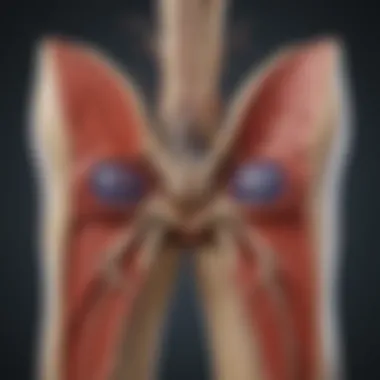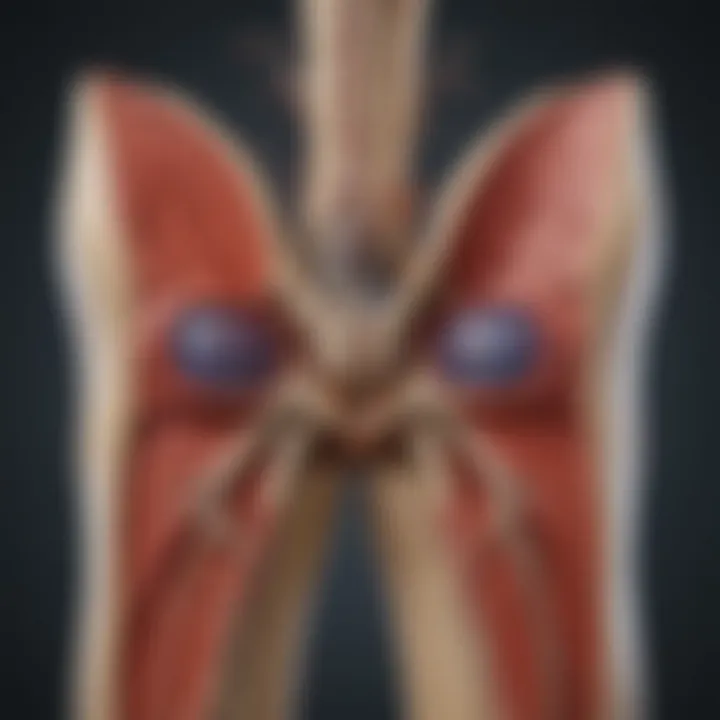Occluded Femoral Artery: Causes, Effects, Treatments


Intro
The occluded femoral artery presents a significant health concern, particularly for individuals at risk of vascular diseases. This condition involves a blockage in one of the major arteries responsible for delivering blood to the lower extremities. Understanding the complexities of this condition entails exploring various aspects such as its anatomy, causes, and consequences. The implications of a blocked femoral artery can be profound, often impacting mobility and overall health. As we navigate through this analysis, our aim is to provide a thorough exploration and understanding of the occluded femoral artery from multiple perspectives.
Recent Advances
Latest Discoveries
Recent research has shed light on several important aspects of occluded femoral arteries. Studies have focused on identifying biomarkers related to arterial health, providing clues to early detection and more tailored treatment approaches. For example, advanced imaging techniques have allowed for a better understanding of plaque composition within the artery.
In addition, clinical trials have tested new medications aimed at improving blood flow. One notable class of drugs includes anti-platelet agents that may help in preventing thrombosis, thus reducing the risk of occlusion in patients predisposed to vascular conditions.
Technological Innovations
Technological innovations are paramount in enhancing the diagnosis and treatment of occluded femoral arteries.
- Non-Invasive Imaging: Techniques such as magnetic resonance angiography (MRA) and computed tomography angiography (CTA) have become essential. These imaging methods help to visualize arterial blockage without the need for invasive procedures.
- Minimally Invasive Surgical Techniques: Procedures such as angioplasty and stenting have evolved. These minimally invasive techniques allow for direct intervention to restore blood flow while reducing recovery time.
Methodology
Research Design
The body of research surrounding the occluded femoral artery utilizes a mix of longitudinal studies and cross-sectional analyses. These studies often focus on diverse populations to understand how various factors contribute to the risk of occlusion.
Data Collection Techniques
Data collection in this field has become increasingly sophisticated. Researchers gather information through methods such as:
- Patient Surveys: Collecting information regarding lifestyle factors and family history.
- Clinical Evaluations: Performing physical examinations to assess symptoms and vascular health.
- Imaging Studies: Utilizing advanced imaging technology to obtain visual data on arterial conditions.
Understanding these methodologies is crucial for advancing the knowledge base surrounding the occluded femoral artery, enhancing both preventive and responsive care strategies.
"A nuanced understanding of the occluded femoral artery is essential for effective patient management and improved health outcomes."
As we delve deeper into this analysis, we will discuss the causes and risk factors that lead to this condition, followed by an exploration of its effects and the available treatment modalities.
Understanding the Structure of the Femoral Artery
The femoral artery is a major vessel in the human circulatory system. Understanding its structure is essential for grasping the complexities surrounding its potential occlusion. The femoral artery plays a critical role in supplying oxygenated blood to the lower limbs. Therefore, any obstruction can have significant health implications.
Anatomical Location
The femoral artery is located in the upper thigh, starting from the inguinal ligament and extending downward. It emerges from the external iliac artery and travels through the femoral triangle, an area bordered by the sartorius, adductor longus, and the inguinal ligament. As it descends, it transitions into the popliteal artery behind the knee. This specific location makes the femoral artery susceptible to various forms of obstruction, including atherosclerosis and thrombosis. Understanding its anatomical placement helps in diagnosing conditions related to blood flow issues in the lower extremities.
Functionality and Blood Supply
The primary function of the femoral artery is to transport blood to the lower limbs. It provides oxygen-rich blood necessary for muscle function and overall mobility. When the femoral artery is occluded, the affected leg experiences reduced blood supply, leading to symptoms such as pain, weakness, and in severe cases, tissue death.
The efficiency of blood flow from the femoral artery also impacts the health of the surrounding tissues, including nerves and skin, as they depend on adequate blood supply for sustaining cellular activities. Thus, recognizing the functionality of the femoral artery is key in appreciating the consequences of occlusion.
Branches of the Femoral Artery
The femoral artery does not function in isolation. It gives rise to several branches that play vital roles in supplying blood to various regions:
- Deep Femoral Artery (Profunda Femoris): This branch supplies blood to the thigh muscles and is crucial for ensuring that the anterior compartment of the thigh receives adequate nourishment.
- Superficial Epigastric Artery: Vital for supplying blood to the skin and subcutaneous tissues in the lower abdomen.
- Superficial Circumflex Iliac Artery: This artery provides blood to the femoral region and skin around the hip.
- External Pudendal Arteries: These arteries are responsible for supplying the genital area.
Each branch of the femoral artery underscores its significance in ensuring adequate blood flow to various structures in the lower body. Together, these components contribute to understanding the potential impacts of occlusion on overall health.
Pathophysiology of Arterial Occlusion
The pathophysiology of arterial occlusion plays a critical role in understanding the mechanisms behind conditions such as occluded femoral artery. This section delves into how occlusion occurs, its physiological implications, and the underlying processes that lead to compromised blood flow. A clear grasp of these mechanisms is vital for both clinical assessment and treatment planning.
Arterial occlusion refers to the blockage within an artery, impeding blood flow. This can arise from various reasons such as thrombosis, embolism, or atherosclerosis. The significance of understanding these processes cannot be overstated, as they influence the symptoms presented and the appropriate interventions required. Recognizing the pathophysiological aspects helps in anticipating complications and implementing preventive measures.
Mechanisms of Occlusion
Arterial occlusion occurs primary through three mechanisms: thrombosis, embolism, and atherosclerosis. Each mechanism contributes distinctively to how blood flow is affected.
- Thrombosis involves the formation of a blood clot within the artery, often triggered by injuries to the vascular endothelium. These clots can partially or completely block blood flow.
- Embolism is characterized by the movement of a blood clot or other debris from another part of the body, which lodges into the femoral artery, obstructing blood supply.
- Atherosclerosis refers to the buildup of plaques in arterial walls that narrow the vessel lumen, leading to reduced blood flow. This process often takes years to develop and is exacerbated by risk factors such as high cholesterol and hypertension.
Understanding these mechanisms is crucial for diagnosing arterial occlusion effectively and determining the best course of action for treatment.
Inflammation and Endothelial Dysfunction
Inflammation and endothelial dysfunction are significant factors in the development of arterial occlusion. When the endothelium—the inner lining of blood vessels—is compromised, it can lead to a cascade of harmful events.
Endothelial dysfunction creates an environment conducive to thrombosis. Factors such as elevated blood pressure, smoking, and high glucose levels can damage the endothelium, promoting inflammation.


This chronic inflammation results in plaque instability, making it more likely to rupture and cause an embolism. As these pathological processes continue, artery walls may thicken and lose elasticity, contributing further to occlusive events.
"The interplay between inflammation and endothelial health forms a critical nexus in the progression of arterial disease."
In summary, pathophysiology of arterial occlusion encompasses critical mechanisms that range from the initial blockages caused by thrombosis to the chronic changes in vessel walls due to atherosclerosis and inflammation. A comprehensive understanding of these will support better outcomes through timely interventions and personalized treatment plans.
Common Causes of Femoral Artery Occlusion
Understanding the common causes behind femoral artery occlusion is crucial. Each of these causes plays a significant role not only in the initial blockage but also in determining the subsequent treatment options and patient outcomes. Recognizing the underlying factors can tailor preventive measures and inform clinical strategies aimed at managing this condition effectively.
Atherosclerosis
Atherosclerosis is the primary cause of femoral artery occlusion. It involves the gradual buildup of plaque within the arterial wall, which narrows the lumen of the artery and restricts blood flow. Over time, this can lead to significant ischemia, particularly in the lower extremities. Risk factors include high cholesterol levels, hypertension, and diabetes. The process is often asymptomatic until sufficient narrowing occurs. Importantly, patients may not recognize the severity of their condition until they experience symptoms such as claudication or rest pain. This topic merits attention, as it highlights the importance of early lifestyle interventions and medical management of risk factors for vascular health.
Atherosclerosis remains a leading cause of limb ischemia, impacting quality of life and mobility.
Embolism
Embolism refers to the obstruction of an artery due to an embolus—typically a blood clot or a piece of plaque that travels from another location in the body. When an embolus lodges in the femoral artery, it can lead to sudden occlusion. This often presents as acute limb ischemia, a medical emergency that requires immediate intervention. Embolic events can arise from various sources, including the heart in patients with atrial fibrillation or from peripheral vascular disease. Understanding embolism is vital for timely diagnosis and intervention, ensuring that the affected limb can be salvaged.
Thrombosis
Thrombosis, in the context of femoral artery occlusion, usually pertains to the formation of a blood clot directly within the artery. This can happen following a period of reduced blood flow or injury to the blood vessel. Certain conditions, such as deep vein thrombosis, can increase the risk of thrombus formation. Unlike embolism, thrombosis usually develops more insidiously, leading to a gradual worsening of symptoms. This makes it crucial for healthcare professionals to monitor patients at risk and advocate for prompt management strategies to prevent occlusion and associated complications.
Patients with a history of vascular disease need to be informed about the symptoms and risk factors linked to thrombosis, as preventative measures can significantly reduce their risk of serious outcomes.
Risk Factors for Occlusion
Understanding the risk factors for femoral artery occlusion is crucial in both clinical and preventative contexts. Addressing these factors can help in identifying individuals who are at higher risk and can lead to timely interventions. The factors influencing occlusion are diverse—it ranges from biological to lifestyle choices. Recognizing these elements can aid healthcare providers and patients alike to mitigate risks and enhance long-term outcomes.
Age and Gender
Age is a significant factor in the likelihood of developing femoral artery occlusion. As individuals grow older, the elasticity of their arteries generally decreases, leading to an increased risk of blockages. This phenomenon is particularly apparent in people over the age of 65. Statistically, men are more prone to arterial occlusion than women, especially in earlier years. The hormonal differences between genders contribute to this disparity. Women typically have some protected vascular benefit before menopause but are at equal risk afterward. Understanding these dynamics can help tailor preventive advice based on age and gender, ultimately reducing the incidence of arterial blockages.
Chronic Conditions
Chronic health conditions can significantly heighten the risk of femoral artery occlusion. Conditions such as diabetes, hypertension, and hyperlipidemia are among the most common culprits. Diabetics often experience issues with circulation due to vascular damage caused by high blood sugar levels. Similarly, hypertension, or high blood pressure, can lead to structural changes in blood vessels over time. Hyperlipidemia, mainly characterized by elevated levels of cholesterol in the blood, promotes atherosclerosis which narrows arteries. Management of these conditions through regular medical consultations can decrease the risk of developing an occlusion and can prevent further complications.
Lifestyle Choices
Lifestyle choices play a vital role in the risk of femoral artery occlusion. Smoking is one of the most significant modifiable risk factors. It not only damages blood vessels but also promotes the formation of plaque within the arteries. Similarly, physical inactivity increases the likelihood of obesity, which further complicates arterial health. Poor dietary choices, particularly diets high in saturated fats and sugars, contribute to the development of conditions like atherosclerosis. By adopting healthier habits—like quitting smoking, engaging in regular exercise, and maintaining a balanced diet—individuals can significantly lower their odds of facing artery-related problems.
It is important to acknowledge that while certain risk factors are beyond personal control, such as age and genetic predisposition, many lifestyle-related factors can be modified with conscious effort.
Clinical Presentation
The clinical presentation of occluded femoral artery is crucial for understanding the diagnosis and management of this condition. Recognizing the symptoms and physical examination findings aids healthcare professionals in determining the extent of the occlusion.
Symptoms of Occlusion
Patients with femoral artery occlusion often experience a range of symptoms. The most notable are:
- Pain in the leg: This can vary from mild to severe, usually worsens with activity, and is often relieved by rest.
- Weakness or numbness: Feelings of weakness or numbness in the legs can occur due to reduced blood flow.
- Coldness in the leg or foot: Affected limbs may feel colder than the other.
- Skin changes: Discoloration, such as paleness or bluish tinge, indicates poor circulation.
- Ulceration or gangrene: In extreme cases, lack of blood flow may lead to serious conditions such as skin ulcers or tissue death.
It is essential for individuals experiencing these symptoms to seek medical evaluation. Early intervention can prevent severe complications.
Physical Examination Findings
The physical examination is a fundamental aspect of diagnosing femoral artery occlusion. Healthcare providers typically assess the following:
- Pulse palpation: Weak or absent pulses in the femoral, popliteal, or distal arteries indicate possible occlusion.
- Blood pressure measurement: Comparing blood pressure in both legs can reveal discrepancies linked to arterial blockage.
- Capillary refill time: Delayed capillary refill in the toes suggests inadequate perfusion.
- Sensory and motor function: Assessment of sensory responses and motor abilities helps determine the impact of the occlusion.
These findings are essential for creating a treatment plan that addresses the specific needs of the patient.
Identifying these signs and symptoms early enhances the management and can potentially improve outcomes for those affected.
Diagnostic Approaches
Understanding the diagnostic approaches to occluded femoral artery is crucial for timely intervention and effective patient management. The right diagnostic technique helps in identifying the extent of occlusion, formulating treatment plans, and monitoring progress after treatment. A comprehensive evaluation involves various imaging methods and blood flow measurement techniques that aid in diagnosing the condition reliably.
Imaging Techniques
Imaging techniques are pivotal in assessing the femoral artery’s condition. They offer valuable insights into the extent of blockage, its morphology, and its potential causes. Three widely used imaging modalities include ultrasound, CT angiography, and MRI. Each brings unique characteristics to the diagnostic table.
Ultrasound
Ultrasound is often the first-line imaging choice due to its non-invasive nature and accessibility. This technique employs sound waves to visualize blood flow in the femoral artery. A key characteristic of ultrasound is its ability to provide real-time images, which is essential for dynamic assessment of blood flow.


One significant advantage of ultrasound is the absence of ionizing radiation, making it a safer choice, especially for patients requiring repeated assessments. Its unique feature lies in Doppler ultrasound, which measures the velocity of blood flow, allowing clinicians to detect abnormalities such as stenosis or occlusion effectively. However, its limitations include operator dependency and difficulty in visualizing deeper structures in overweight patients.
CT Angiography
CT angiography is a more advanced imaging technique that uses X-rays to produce detailed cross-sectional images of the femoral artery. A critical feature of CT angiography is its rapid acquisition of images, which facilitates the assessment of complex vascular structures.
This method is particularly beneficial for its ability to visualize both the arteries and adjacent soft tissues simultaneously. The unique advantage of CT angiography is its high spatial resolution, which enhances the detection of small vascular lesions. However, it involves exposure to ionizing radiation and the use of contrast agents, which may pose risks for certain patients.
MRI
MRI offers a different approach as it uses magnetic fields and radio waves to create detailed images of the arterial structures. A distinguishing characteristic of MRI is its ability to provide high-contrast images without radiation. This makes it a favorable option for monitoring vascular conditions in younger patients or those who require frequent follow-up.
MRI's unique feature includes its capability to assess not only the anatomy but also the hemodynamics through techniques like MR angiography. Despite its advantages, MRI can be less accessible and may require patients to remain still for extended periods, which can be challenging for some individuals.
Blood Flow Measurement
Blood flow measurement techniques complement imaging modalities, providing quantitative data on arterial perfusion. These techniques involve using various methods to assess the adequacy of blood supply to the lower limbs. Doppler ultrasound is one of the most common methods used for this purpose, as it offers a non-invasive option to evaluate blood flow dynamics.
Other methods may include plethysmography, which measures changes in volume in an organ or limb, providing additional details about blood flow. Collectively, these diagnostic approaches form a multi-faceted strategy essential for the effective evaluation and management of occluded femoral artery.
Management Strategies
The management of occluded femoral artery is crucial as it directly affects the quality of life, mobility, and overall health of the patient. Effective management strategies encompass both medical and surgical treatments, which aim to restore blood flow, alleviate symptoms, and prevent further complications.
A multifaceted approach to management is necessary to achieve optimal outcomes. It is essential for healthcare professionals to tailor treatments based on the individual patient’s condition, underlying causes, and overall health status. In this context, understanding the available medical and surgical interventions is key to finding the best path forward.
Medical Treatments
Medical treatments for occluded femoral artery focus on managing symptoms and improving blood flow. Commonly prescribed medications include anticoagulants and antiplatelet agents. These drugs are essential in preventing further clot formation by thinning the blood or inhibiting platelet aggregation. Medications like aspirin and clopidogrel are frequently utilized in treatment regimens.
In addition, statins play a significant role by helping to lower cholesterol levels, thereby slowing the progression of atherosclerosis, which is a common cause of arterial occlusion. Other treatments may involve medications to control blood pressure and diabetes, as these are major risk factors contributing to vascular disease.
Surgical Interventions
When medical management fails or when the occlusive condition is severe, surgical interventions may be necessary. Several surgical procedures are available, tailored to the specific needs of the patient. Each intervention has its unique features, benefits, and drawbacks.
Bypass Surgery
Bypass surgery involves creating an alternative pathway for blood to flow around the occluded area of the femoral artery. Typically, this is done using a graft, which can be made from a vein taken from another part of the patient’s body or a synthetic material. The primary characteristic of bypass surgery is its ability to effectively restore blood flow to the affected limb. This procedure is often viewed as a powerful treatment option for occlusion because it can significantly improve mobility and reduce pain.
However, bypass surgery is an invasive procedure and may not be suitable for all patients. The unique feature of this surgery is its long-term effectiveness; many patients experience lasting relief from symptoms. Nevertheless, potential complications, such as graft failure or infection, must be considered.
Angioplasty
Angioplasty is less invasive compared to bypass surgery. It involves using a balloon catheter to open up the blocked artery. The process usually includes placing a tiny balloon at the site of the occlusion, which is then inflated to widen the artery. This method is advantageous due to its minimally invasive nature, leading to shorter recovery times and less postoperative discomfort.
The key characteristic of angioplasty is that it can preserve the natural artery, maintaining vascular architecture. However, there is a risk of restenosis, where the artery can narrow again after the procedure. Despite this, angioplasty is a common choice due to its effectiveness in many situations.
Stenting
Stenting is often performed in conjunction with angioplasty. It involves placing a small mesh tube within the artery to keep it open after the blockage has been cleared. The primary benefit of stenting is its ability to support the artery and prevent future occlusion. This makes it a preferred option for many clinicians and patients.
The unique feature of stenting is that it can localize treatment to a specific site without requiring larger surgical procedures. However, complications such as stent thrombosis can occur. Additionally, patients may require ongoing use of antiplatelet medications to minimize this risk.
In summary, the management strategies for occluded femoral artery combine both medical and surgical options tailored to patient needs. Understanding these modalities allows for an informed decision-making process regarding treatment and monitoring the progression of the disease.
Post-treatment Rehabilitation
Post-treatment rehabilitation plays a crucial role in the recovery process after an occlusion of the femoral artery. It helps patients regain mobility, strength, and overall well-being. The rehabilitation process often includes two key components: physical therapy and lifestyle modifications. Together, these strategies aim to enhance recovery and reduce future risks associated with arterial occlusion.
Physical Therapy
Physical therapy is an essential element of post-treatment rehabilitation. It aims to restore the function of the leg and improve blood circulation. By working with a qualified therapist, patients can engage in tailored exercises that gradually enhance their strength and mobility. Therapy programs often include both cardiovascular exercises and strength training.
Some specific benefits of physical therapy include:
- Improved Mobility: Exercises help in regaining range of motion in the leg.
- Pain Management: Targeted therapies can reduce pain associated with recovery.
- Circulation Enhancement: Activities boost blood flow, assisting in the recovery of the affected area.
- Strength Building: Rehabilitation focuses on strengthening the muscles surrounding the femoral artery, improving support and function.
It is vital for patients to consistently attend therapy sessions and follow their therapist's guidance. Individualized programs are often developed based on the patient’s specific condition and progress.
Lifestyle Modifications
Making significant lifestyle changes is another critical aspect of post-treatment rehabilitation. Such modifications can lead to better overall health and decrease the chances of future occlusions.
Here are some lifestyle changes that are often recommended:
- Healthy Diet: Consuming a diet rich in vegetables, fruits, and whole grains can help manage cholesterol levels and blood pressure.
- Regular Exercise: Engaging in light to moderate exercises, such as walking, can improve cardiovascular health. It's important for individuals to adapt these exercises based on their recovery stage.
- Smoking Cessation: Stopping smoking can dramatically lower the risk of further arterial issues and improve healing.
- Weight Management: Maintaining a healthy weight reduces pressure on the arteries and supports overall cardiovascular function.


Adopting these lifestyle changes is not an easy task. However, they can lead to lasting benefits for mobility and overall health. It is essential to consult healthcare professionals for guidance tailored to individual needs.
"Post-treatment rehabilitation is not just about healing the injury; it's about creating a framework for long-term health and prevention."
Together, physical therapy and lifestyle modifications create a comprehensive rehabilitation strategy. This approach not only aids recovery but also empowers patients to take control of their health. By focusing on both physical and lifestyle adaptations, individuals maximize their potential for recovery and minimize risks of recurrence.
Long-term Prognosis
The long-term prognosis for individuals with occluded femoral artery is a vital aspect to consider in the management and treatment of the condition. It not only aids in understanding the outcomes after medical interventions but also emphasizes the need for preventive measures. This outlook helps both healthcare professionals and patients in setting realistic expectations regarding recovery, mobility, and overall health.
Outcomes After Treatment
Effective treatment of occluded femoral artery can lead to significant improvements in both cardiovascular health and quality of life. Patients who undergo surgical interventions like bypass surgery or angioplasty often experience restored blood flow, enhancing mobility and reducing leg pain associated with claudication.
Research indicates that patients who engage in post-treatment rehabilitation can see a notable improvement in their functional capacity. Exercise programs tailored for recovery not only boost strength and endurance but also contribute to a healthier lifestyle. Post-treatment outcomes can be influenced by several factors:
- Age and Coexisting Conditions: Older adults or those with chronic diseases may have varied responses to treatment.
- Post-surgical Care: Adhering to medical advice post-surgery is crucial for sustained improvement.
- Lifestyle Changes: Patients who adopt healthier habits have a higher likelihood of beneficial outcomes.
Individuals typically report decreased symptoms of leg pain and improved walking distances within months after treatment. However, consistent monitoring is essential to assess ongoing health and detect any potential complications.
Risk of Recurrence
While successful treatment can yield positive outcomes, the risk of recurrence remains a pressing concern. Patients previously diagnosed with femoral artery occlusion are at a heightened risk of developing new blockages or experiencing recurrent issues. Various factors contribute to this elevated risk, including high cholesterol levels, uncontrolled hypertension, and ongoing lifestyle choices that promote vascular disease.
To mitigate this risk, regular follow-up appointments and monitoring are necessary. Patients are advised to:
- Manage Risk Factors: Engaging in lifestyle changes such as adopting a heart-healthy diet and regular exercise is crucial.
- Participate in Follow-ups: Regular visits to healthcare providers can assist in early detection of issues.
- Educate Themselves: Understanding the signs of recurrence can empower patients to seek timely medical advice.
In summary, the long-term prognosis for femoral artery occlusion revolves around understanding effective treatment outcomes and recognizing the risk factors associated with recurrence. By combining treatment with preventive measures, patients can improve their quality of life and reduce the likelihood of future complications.
Preventive Strategies
Preventive strategies are vital for managing the risk factors associated with the occluded femoral artery. Early intervention can help reduce the incidence of this condition, preserving mobility and overall health. The significance of these strategies lies in their ability to address the underlying causes and risk factors before they lead to serious medical concerns.
Healthy Lifestyle Choices
Adopting healthy lifestyle choices is a fundamental preventive measure against femoral artery occlusion. The following elements play a crucial role:
- Regular Exercise: Engaging in physical activity helps maintain healthy blood flow and can lower cholesterol levels. Aim for at least 150 minutes of moderate exercise weekly.
- Balanced Diet: Emphasizing whole foods, such as fruits, vegetables, whole grains, and lean proteins, can reduce the risk of atherosclerosis. Limiting saturated fats and trans fats is also crucial.
- Weight Management: Maintaining a healthy weight reduces strain on the cardiovascular system. A body mass index (BMI) within the normal range is linked to a lower risk of occlusion.
- Avoiding Tobacco: Smoking significantly increases the risk of arterial occlusion. Quitting smoking can greatly improve vascular health.
Implementing these choices leads to better overall health outcomes and reduces the likelihood of occlusion in the femoral artery.
Monitoring and Screening Practices
Monitoring and screening practices are equally important in the prevention of arterial occlusion. Regular check-ups and assessments allow for early detection of risk factors. These practices include:
- Blood Pressure Monitoring: High blood pressure can damage blood vessels. Regular checks help manage and control this condition, reducing the risk of occlusion.
- Cholesterol Level Checks: Knowing cholesterol levels is critical. Elevated levels can lead to plaque buildup, increasing the risk for atherosclerosis.
- Diabetes Screening: Since diabetes is a significant risk factor, regular screening is important. Proper management of blood sugar levels can prevent complications related to arterial damage.
Regular monitoring provides an opportunity to intervene before problems escalate, making it an essential part of prevention.
Research Trends and Innovations
Research on occluded femoral artery has become increasingly important, as it provides insights into how to better manage the condition. Understanding current trends in this field helps professionals stay updated on the latest developments, ultimately improving patient outcomes. Various aspects like treatment methods, patient care, and diagnostic tools are evolving, which merits a thorough exploration.
Emerging Therapies
Recent advancements have led to the emergence of novel therapies that aim to enhance recovery and promote blood flow in occluded femoral arteries. These therapies offer a variety of benefits:
- Regenerative Medicine: This area focuses on repairing or replacing damaged tissues. For the femoral artery, cell-based therapies might stimulate healing, potentially reversing the compromised blood flow.
- Gene Therapy: Techniques in gene editing, like CRISPR, show promise in targeting underlying genetic factors contributing to occlusion. This can redefine traditional approaches by addressing root causes rather than only symptoms.
- Pharmacological Innovations: New drugs that focus on mechanisms of arterial healing are being tested. These medications can prevent the formation of plaques or enhance the effectiveness of current treatments.
Such therapies reflect a shift towards more personalized medicine. With ongoing studies assessing their efficacy, patients could have access to better management strategies in the near future.
Advances in Imaging Techniques
Advancements in imaging technologies play a crucial role in diagnosing and managing femoral artery occlusions. Better imaging allows healthcare providers to visualize arterial blockages accurately and assess the severity of the condition, which is vital for choosing the appropriate treatment strategy.
- High-resolution Ultrasound: This non-invasive technique is becoming more popular due to its efficiency in evaluating blood flow and detecting potential occlusions without exposing patients to radiation.
- Computed Tomography Angiography (CTA): CTA continues to evolve, providing detailed images of blood vessels. Its ability to capture complex arterial structures makes it a valuable tool in the diagnostic process.
- Magnetic Resonance Imaging (MRI): Recent developments in MRI technology allow for enhanced imaging of vascular conditions. The use of contrast agents has improved the capability to determine blood flow conditions around the occluded areas.
These imaging techniques contribute significantly to better clinical decision-making. By integrating advanced imaging in routine assessments, professionals can ensure timely interventions, which often leads to improved patient outcomes.
End
The final section of this article synthesizes the vast information presented regarding the occluded femoral artery. Understanding the complexities surrounding this condition is essential in clinical practice and patient management. Occlusion can lead to significant morbidity and impact an individual's mobility and overall quality of life.
Summary of Key Findings
Through this exploration, several key findings emerged:
- Anatomy and Function: The femoral artery plays a crucial role in supplying blood to the lower limbs. Understanding its anatomy is fundamental in diagnosing occlusions.
- Causes and Risk Factors: Atherosclerosis, thrombosis, and embolism are primary causes, intertwined with risk factors such as age, lifestyle choices, and underlying chronic conditions.
- Symptoms and Clinical Signs: Recognizing symptoms early, such as intermittent claudication, is vital for timely intervention.
- Diagnostic Techniques: Advanced imaging methods, like ultrasound and CT angiography, are essential for accurate diagnosis and assessment.
- Treatment Options: There is a spectrum of management strategies, from medical therapies to surgical interventions, illustrating the need for a personalized approach to treatment.
- Preventive Strategies: Emphasizing healthy lifestyle choices can mitigate risk, promoting overall vascular health.
Implications for Future Research
Future research is necessary to advance our understanding of occluded femoral artery. Several areas are ripe for investigation:
- Innovative Therapies: Exploring new medical therapies, particularly those that focus on reversing or stabilizing plaque build-up, could change outcomes significantly.
- Longitudinal Studies: More extensive studies on the long-term effects of interventions could provide insights into best practices.
- Patient Education: Investigating how better patient education affects compliance with lifestyle changes can improve management outcomes.
- Technological Advancements: Continued advancements in imaging technology may enhance early detection and precision in diagnosing femoral artery occlusion.















